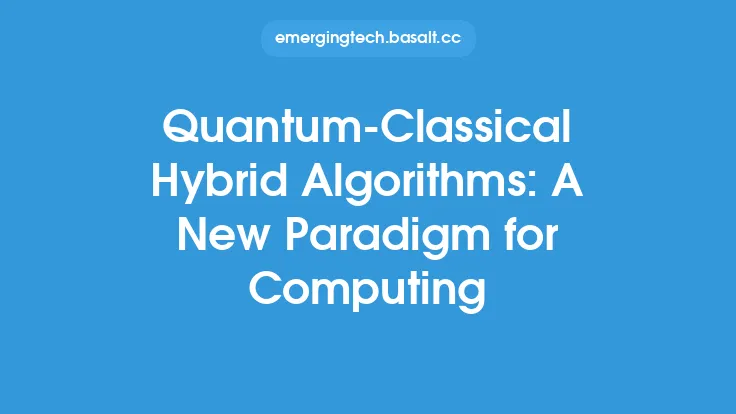The pursuit of quantum computing has led to the development of various architectures, each with its strengths and weaknesses. As researchers and engineers continue to push the boundaries of quantum computing, a new paradigm has emerged: hybrid quantum-classical architectures. This approach combines the benefits of quantum computing with the robustness and scalability of classical computing, paving the way for a new generation of quantum computing systems.
Introduction to Hybrid Quantum-Classical Architectures
Hybrid quantum-classical architectures aim to leverage the strengths of both quantum and classical computing to achieve improved performance, efficiency, and scalability. By integrating quantum processors with classical systems, these architectures can tackle complex problems that are currently intractable or require an unfeasible amount of computational resources. The hybrid approach enables the use of quantum computing for specific tasks, such as simulations, optimization, and machine learning, while relying on classical computing for tasks that are more suited to traditional architectures, like data processing and control.
Key Components of Hybrid Quantum-Classical Architectures
A hybrid quantum-classical architecture typically consists of several key components:
- Quantum Processor Unit (QPU): This is the quantum computing component, responsible for executing quantum algorithms and operations. The QPU can be based on various quantum technologies, such as superconducting qubits, ion traps, or topological quantum computing.
- Classical Processor Unit (CPU): The CPU is the classical computing component, handling tasks like data processing, control, and communication with the QPU.
- Quantum-Classical Interface: This interface enables communication and data transfer between the QPU and CPU, allowing for the integration of quantum and classical computing.
- Control and Calibration Systems: These systems are responsible for controlling and calibrating the QPU, ensuring that it operates within the desired parameters and maintains its quantum coherence.
Benefits of Hybrid Quantum-Classical Architectures
The hybrid approach offers several benefits, including:
- Improved Scalability: By leveraging classical computing for tasks that are not well-suited to quantum computing, hybrid architectures can scale more efficiently and effectively.
- Enhanced Robustness: The integration of classical computing can help mitigate the effects of quantum noise and errors, making the overall system more robust and reliable.
- Increased Flexibility: Hybrid architectures can be designed to accommodate a wide range of quantum and classical computing tasks, making them more versatile and adaptable to different applications.
- Better Resource Utilization: By allocating tasks to the most suitable computing paradigm (quantum or classical), hybrid architectures can optimize resource utilization and reduce waste.
Challenges and Limitations
While hybrid quantum-classical architectures offer many benefits, they also present several challenges and limitations:
- Quantum-Classical Interface: Developing an efficient and reliable interface between the QPU and CPU is a significant challenge, requiring advances in quantum control, calibration, and communication.
- Quantum Noise and Error Correction: Mitigating the effects of quantum noise and errors remains a major challenge, particularly in large-scale quantum systems.
- Scalability and Complexity: As the number of qubits and quantum gates increases, the complexity of the system grows exponentially, making it harder to control, calibrate, and maintain.
- Software and Programming: Developing software and programming frameworks that can effectively utilize hybrid quantum-classical architectures is an ongoing challenge, requiring advances in quantum programming languages, compilers, and runtime environments.
Applications and Use Cases
Hybrid quantum-classical architectures have a wide range of potential applications, including:
- Optimization and Simulation: Hybrid architectures can be used to solve complex optimization problems and simulate complex systems, such as molecules, materials, and chemical reactions.
- Machine Learning and Artificial Intelligence: The integration of quantum and classical computing can accelerate machine learning and AI workloads, enabling faster and more accurate processing of large datasets.
- Cryptography and Cybersecurity: Hybrid architectures can be used to develop new cryptographic protocols and techniques, enhancing cybersecurity and protecting against quantum computer-based attacks.
- Materials Science and Nanotechnology: Hybrid quantum-classical architectures can simulate the behavior of materials at the atomic and subatomic level, enabling the discovery of new materials and properties.
Future Directions and Research
As research and development in hybrid quantum-classical architectures continue to advance, several areas are expected to receive significant attention:
- Quantum-Classical Interface Development: Improving the efficiency, reliability, and scalability of the quantum-classical interface will be crucial for the widespread adoption of hybrid architectures.
- Quantum Error Correction and Mitigation: Developing robust and efficient methods for quantum error correction and mitigation will be essential for large-scale quantum computing applications.
- Software and Programming Frameworks: Creating software and programming frameworks that can effectively utilize hybrid quantum-classical architectures will be critical for the development of practical applications.
- Materials Science and Quantum Computing: Exploring the intersection of materials science and quantum computing will lead to new discoveries and innovations, enabling the development of novel materials and properties.
Conclusion
Hybrid quantum-classical architectures represent a significant step forward in the development of quantum computing, offering improved scalability, robustness, and flexibility. While challenges and limitations remain, the potential benefits and applications of these architectures make them an exciting and promising area of research. As scientists and engineers continue to advance the field, we can expect to see significant breakthroughs and innovations, ultimately leading to the widespread adoption of hybrid quantum-classical architectures in a variety of fields and applications.





